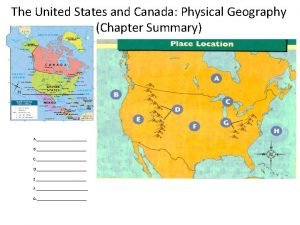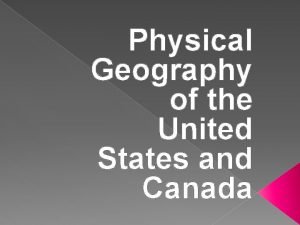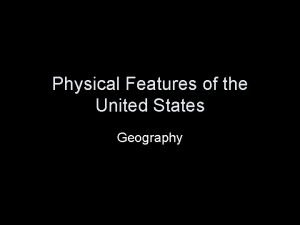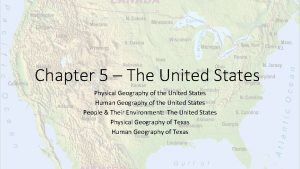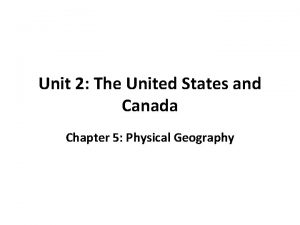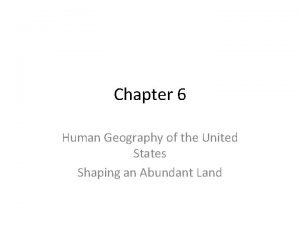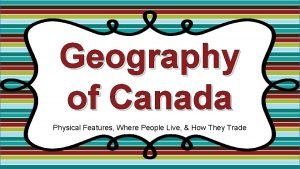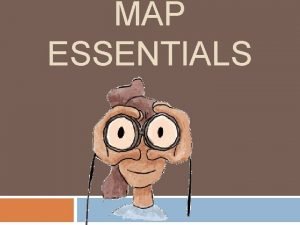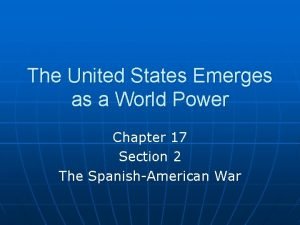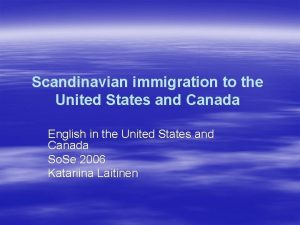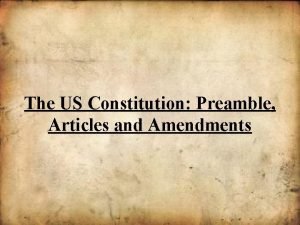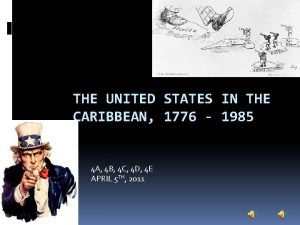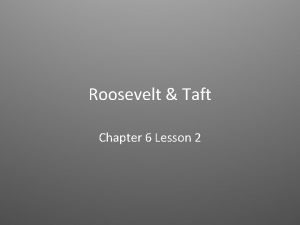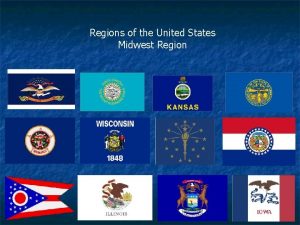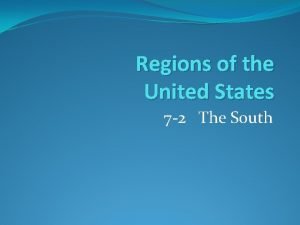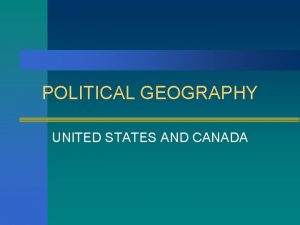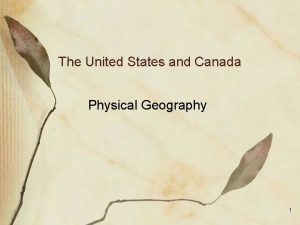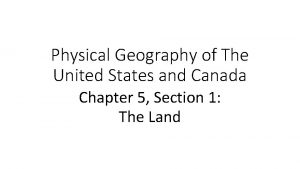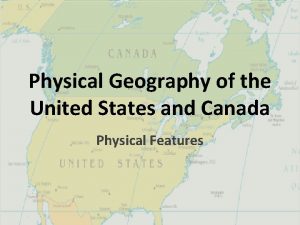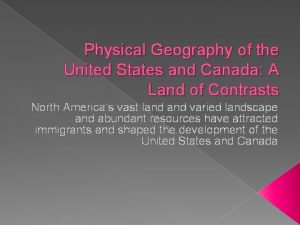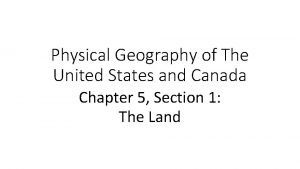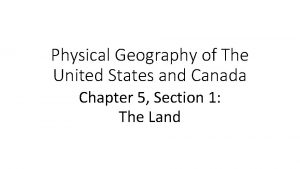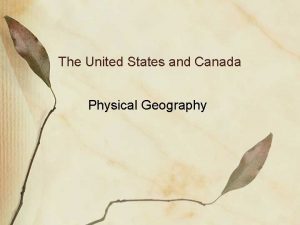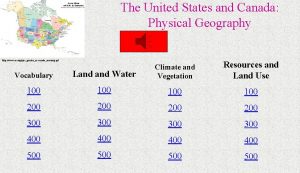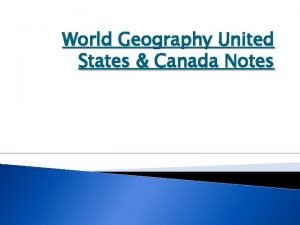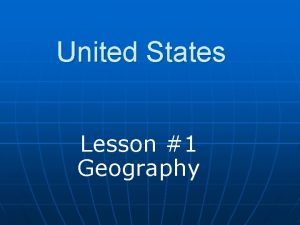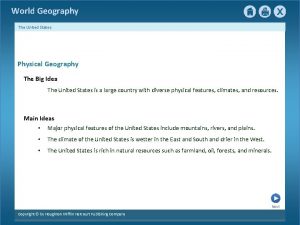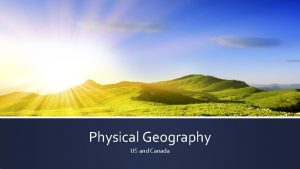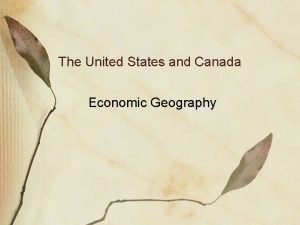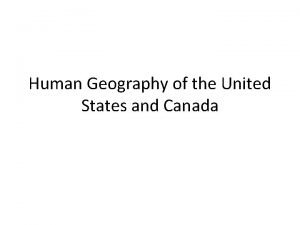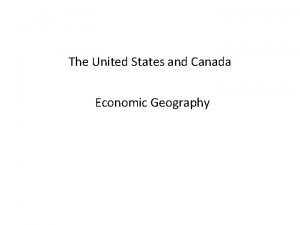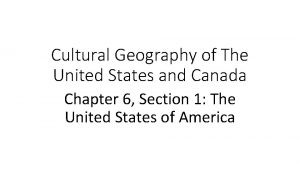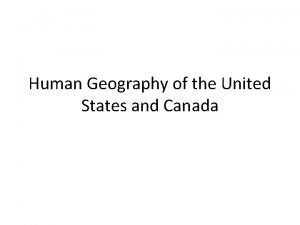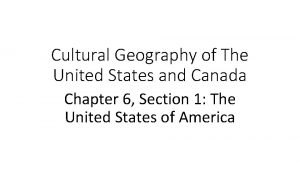Physical Geography of the United States and Canada

































- Slides: 33

Physical Geography of the United States and Canada: A Land of Contrasts North America’s vast and varied landscape and abundant resources have attracted immigrants and shaped the development of the United States and Canada.

Section 1: Landforms and Resources • The United States and Canada have vast lands and abundant resources. • These two countries share many of the same landforms. http: //www. freewebs. com/canada-geo/maps. htm

Landscape Influenced Development • U. S. , Canada: former British colonies, most people speak English • Strong economic and political ties with one another

Vast Lands U. S. and Canada • Canada second largest country in the world by area; U. S. third • Together they cover one-eighth of the earth’s land surface.

Abundant Resources • Landmass and natural resources attract immigrants to both countries. • U. S. and Canada have developed into global economic powers.

Many and Varied Landforms • All major landforms are found in U. S. and Canada • The two countries share mountain chains and interior plains Mountains and Plains Deserts Rivers


The Appalachian Highlands - Appalachian Mountains run 1, 600 miles from Newfoundland to Alabama - include Green and Catskill mountains in the north - Blue Ridge and Great Smoky mountains in the south - More than 400 million years old - Erosion has created gentle slopes, peaks from 1, 200– 2, 400 feet - The Appalachian Trail is a scenic hiking path along the chain http: //www. free-desktop-backgrounds. net/Nature-landscapes-wallpapers/Mountainswallpapers/Appalachian-mountains-landscape. html

The Interior Lowlands - Glaciers leveled the land, left fertile soil - Interior Plains extend from Appalachians to Missouri River - Great Plains extend from Missouri River to Rocky Mountains - Canadian Shield—vast, flat area around Hudson Bay Roundtheworldticket. com

The Western Mountains, Plateaus, and Basins • • - Rocky Mountains run 3, 000 miles from Alaska to New Mexico - Relatively young: 80 million years old - Less erosion means rugged, 12, 000 -foot, snow-covered peaks - Continental Divide—the line of highest points along the Rockies - separates rivers that flow eastward from those that flow westward

The Western Mountains, Plateaus, and Basins • • Other Pacific mountain ranges: Sierra Nevada, Cascade Continent’s highest peak: Denali in Alaska Major earthquake activity in Pacific ranges Between ranges and Rockies: cliffs, canyons, basins (low desert)

The Islands • Canada’s large, northern islands: Ellesmere, Victoria, Baffin • U. S. : Aleutians (Alaska), Hawaiian (politically, not geographically) Aleutian Islands, Alaska Hawaiian Islands

Resources Shape Ways of Life • Oceans and Waterways • U. S. and Canada are bounded by: o Atlantic, Pacific, Arctic Oceans o Gulf of Mexico • Countries have many large, inland rivers and lakes that provide: o transportation, hydroelectric power, irrigation, fresh water, fisheries

Oceans and Waterways • Great Lakes: Lakes Huron, Ontario, Michigan, Erie, and Superior • Mississippi-Missouri-Ohio river system: continent’s longest, busiest • Mackenzie River: longest in Canada, crosses Northwest Territories HOMES

Land Forests • Fertile soil helps make North America world’s leading food exporter • Large forests yield lumber and other products

Minerals and Fossil Fuels • Mineral quantity and variety make rapid industrialization possible o Canadian Shield: iron ore, nickel, copper, gold, uranium o Appalachians, Great Plains: coal o Gulf of Mexico: oil, natural gas • U. S. : biggest energy consumer; gets most of Canada’s energy exports

Section 2: Climate and Vegetation v Almost every type of climate is found in the 50 United States because they extend over such a large area north to south. v Canada’s cold climate is related to its location in the far northern latitudes.

Shared Climates and Vegetation • U. S and Canada Climates • U. S. has more climate zones than Canada • U. S. : moderate mid-latitudes, Canada: colder high latitudes

Colder Climates • Arctic coast is tundra: huge, treeless plain with long, cold winters o some permafrost—permanently frozen ground • Rockies and Pacific ranges are highland: colder, sparse vegetation o affect weather in lower areas: block Arctic air, trap Pacific moisture

Moderate Climates • North central, northeast U. S, southern Canada are humid continental o cold winters; warm summers; heavy agriculture • Pacific coast has marine west coast climate o warm summers; long, mild, rainy winters; mixed vegetation o climate affected by ocean currents, coastal mountains, westerlies o prevailing westerlies—middle-latitude winds blowing west to east

Differences in Climate and Vegetation Ø Milder Climates • Much of U. S. located south of 40 degrees N latitude o milder, dry, and tropical climates • Southern states are humid subtropical o Hot, humid summers; mild winters; long growing season for a variety of crops

Ø Dry Climates • Great Plains, northern Great Basin semiarid: dry with short grasses • Southwest is hot, dry desert, including Mojave and Sonoran deserts

Ø Tropical Climates • Hawaii is tropical wet: rain forests, temps around 70 degrees F o Mount Waialeale on Kauai Island is one of the wettest spots on earth • South Florida is tropical wet and dry: warm with tall grasses o Everglades—swampland covering 4, 000 square miles

Effects of Extreme Weather Ø Natural Hazards • Warm Gulf air clashes with cold Canadian air over the Great Plains o creates thunderstorms, tornadoes, blizzards • Hurricanes sweep the Gulf and Atlantic coasts in summer and fall • Heavy rains cause floods along big rivers like the Mississippi • Heat, lack of rain bring droughts, dust storms, forest fires

Section 3: Human-Environment Interaction v Humans have dramatically changed the face of North America. v European settlements in the United States and Canada expanded from east to west.

Settlement and Agriculture Alter the Land Ø Settlement • Before humans, land changed due to natural forces: weather, erosion • Human settlers adapted to, and changed, the environment • First North Americans were nomads, moving from place to place o migrated from Asia over Beringia, a land bridge from Siberia to Alaska o hunted, fished, and gathered plants; settled near rivers and streams

Agriculture • Agriculture replaced hunting and gathering 3, 000 years ago • Settlements became permanent cut down trees for houses, plow fields, dig irrigation ditches o plant corn, beans, squash o • Today U. S. and Canada are leading agriculture exporters

Overcoming Distances Ø Trails and Inland Waterways • First natives go east, south down Pacific coast; some remain north • Europeans colonize the east coast then go inland, creating trails national and Wilderness roads, Oregon and Santa Fe trails o use Mississippi and Ohio rivers; build canals o Erie Canal—first navigable water link between Atlantic, Great Lakes o

• St. Lawrence Seaway—deepwater ship route built by U. S. and Canada • Connects Great Lakes to Atlantic by way of St. Lawrence River • Gated-off sections called locks raise and lower the water and ships • Large ocean vessels can get to industrial and agricultural heartland

Transcontinental Railroads - Transcontinental—from the Atlantic Ocean to the Pacific Ocean - Builders of early-1800 s railroads face many natural barriers - workers cut down forests, bridge streams, tunnel through mountains - First U. S. transcontinental railroad: 1860; first Canadian: 1885 - Move goods, people; promote economic development, national unity - Today U. S. has world’s largest rail system; Canada, third largest

http: //plainshumanities. unl. edu/peattie/ep. nov. jtw. intro. html

National Highway Systems • Arrival of automobile spurs road building in early 20 th century • Today U. S. has 4 million miles of roads, Canada has 560, 000 miles • Large Canadian highways connect major southern cities from east to west o Trans-Canada Highway: 4, 860 miles, Newfoundland to British Columbia • U. S. interstate highway system: 46, 000 -mile network begun in 1950 s

Bibliography • Mcdougal Littell, World Geography. Houghton Mifflin Company. 2012
 Define landform
Define landform United states and canada physical map
United states and canada physical map What are some physical features of the united states
What are some physical features of the united states Physical geography of the united states
Physical geography of the united states What states are west of the mississippi river
What states are west of the mississippi river Mediterranean climate in us
Mediterranean climate in us Chapter 5 section 1 landforms and resources
Chapter 5 section 1 landforms and resources Why is the united states called a postindustrial economy
Why is the united states called a postindustrial economy Canada's physical geography
Canada's physical geography What is the message
What is the message Map of the world with longitude and latitude lines
Map of the world with longitude and latitude lines Us history regents essay
Us history regents essay United states acquisitions and annexations 1857-1904
United states acquisitions and annexations 1857-1904 Immigration to the united states
Immigration to the united states Was the united states on the axis powers or allied powers?
Was the united states on the axis powers or allied powers? Sectionalism map of the united states
Sectionalism map of the united states Us pro soccer teams
Us pro soccer teams Marshall case
Marshall case United states student association
United states student association The united states ought to provide a universal basic income
The united states ought to provide a universal basic income Us constitution preamble
Us constitution preamble The united states in the caribbean 1776 to 1985
The united states in the caribbean 1776 to 1985 Products of the southeast
Products of the southeast Expansion of the united states of america 1607 to 1853 map
Expansion of the united states of america 1607 to 1853 map When did nicholas novikov write the telegram
When did nicholas novikov write the telegram Previous owner of oregon territory
Previous owner of oregon territory Mapp v ohio
Mapp v ohio We have pacified some thousands of the islanders
We have pacified some thousands of the islanders Lesson 2 roosevelt and taft
Lesson 2 roosevelt and taft Midwest region of the united states
Midwest region of the united states 7 regions of the united states
7 regions of the united states The united states is the greatest buyer positive degree
The united states is the greatest buyer positive degree 50 nifty united states
50 nifty united states Chapter 2 free enterprise in the united states answer key
Chapter 2 free enterprise in the united states answer key
